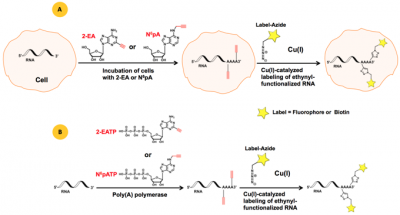Poly(A) tails, a long chain of adenosine nucleotides of variable length, are posttranscriptionally added to the 3'-end of eukaryotic mRNAs by poly(A) polymerase (polyadenylation). This modification plays a critical role in mRNA metabolism and thus gene regulation e.g. by influencing mRNA stability, nuclear export and translation efficiency[1]. Traditional methods for the analysis of poly(A) tails do not allow the discrimination between preexisting and newly polyadenylated mRNA transcripts e.g. induced by changes in signaling pathways.
Two CLICK-functionalized adenosine analogs - N6-Propargyl-Adenosine (N6pA)[2] and 2-Ethynyl-Adenosine (2-EA)[3] have been reported as suitable substrates for poly(A) tail synthesis (polyadenylation) monitoring in mammalian cells. N6pA and 2-EA are cell permeable and incorporate instead of their natural analog adenosine both transcriptionally by RNA polymerase I, II and III and post-transcriptionally by poly(A) polymerase (Figure 1A). In vitro polyadenylation can be performed using the ATP analogs N6-Propargyl-ATP (N6pATP) or 2-Ethynyl-ATP (2-EATP) that serve as substrates for poly(A) polymerase from cell extracts[2] (Figure 1B).

Figure 1: A) Principle of in vivo polyadenylation with the cell-permeable ethynyl-functionalized analogs 2-EA or N6pA[3], respectively. B) Principle of in vitro polyadenylation with ethynyl-functionalized ATP analogs 2-EATP[2] or N6pATP[3], respectively. The resulting ethynyl-functionalized RNA (population) can subsequently be labeled via Cu(I)-catalyzed click reactions, allowing introduction of a Biotin group for subsequent purification tasks (via Azides of Biotin) or a fluorescent group for subsequent microscopic imaging (via fluorescent Azides).
[1] Colgan et al. (1997) Mechanism and regulation of mRNA polyadenylation. Genes Dev. 11:2755.
[2] Grammel et al. (2012) Chemical Reporters for Monitoring RNA synthesis and Poly(A) Tail dynamics. ChemBioChem 13:1112.
[3] Curanovic et al. (2013) Global profiling of stimulus-induced polyadenyation in cells using a poly(A) trap. Nature Chemical Biology 9:671.